This is a compilation of the designer diary entries posted in the Libertalia Facebook group. They are listed here in chronological order, with the most recent entry at the top.
***
February 11: Rulebooks, Insert, and What’s Next
Before I jump in for the final design diary, I just want to thank everyone who has read along, liked, and commented on these posts. I love composing them, but not in a vacuum—it’s you who make this journey special. I’m grateful for your enthusiasm and curiosity, and I look forward to continuing that journey in the coming days and months.
So far I haven’t mentioned the insert, lid, and tray we designed with Panda to aid with storage and setup. It actually took quite a bit of work to get this right, as it’s a lot of content to fit into the box, especially with separate storage for each player’s graveyard tile, character cards (sleeved or unsleeved), and score dial.
But we made it work after several iterations, and we were also able to include a little “treasure tray” for the doubloons so your coins aren’t swimming around the box.
Libertalia includes 2 rulebooks: multiplayer and solo. Both are 8 pages, carefully constructed by Christine Santana and proofread by our oversight team. And you’ll notice that they’re smaller than normal (length and width), as I really like the observation shared by Jack on the Cardboard Herald YouTube channel about how smaller rulebooks are easier to keep on the table for reference. You can find the rulebooks here (I’d recommend downloading them, as previewing on Dropbox can result in some glitches).
When I sat down to write the rulebook, I decided to do so without referencing the original rulebook, as I wanted it to flow naturally for this new edition. It was nice to have the original rulebook to ensure I had included everything and to compare the way we phrased the rules.
The multiplayer rule video from Rodney at Watch It Played will be available in the near future, as well as an interactive rule app from Dized.
What’s next? Here are a few key dates, and remember to sign up for the preorder launch notification here: http://eepurl.com/hP1MZr
- February 12: A few content creators may start to showcase objective content (unboxings, playthroughs, etc) on this date.
- February 15: Advance copy reviewers may start sharing their opinions on this date.
- March 2: Preorders open on the Stonemaier Games webstore. This is also when you’ll know the cost of the game. Both it and the metal coins will be discounted through March 5
- March 3-11: Preorders ship to customers from fulfillment centers in the US, Canada, UK, and Australia.
- Late April: Worldwide English retail release date (localization partners will announce their own dates)
I’ll post all of the reviewer content on our website as it’s released.
Thanks again for following along, and I can’t wait to hear your stories and impressions in March and beyond!
February 10: Automa Solo Mode and Teaser Trailer
A major addition to Libertalia: Winds of Galecrest is the robust Automa solo mode created by Lines J. Hutter and Morten Monrad Petersen. Lines is here today to tell the story of the solo mode and explain how it works. Also, at the end of the post you’ll find a link to the teaser trailer video for Libertalia: Winds of Galecrest (storyboard by Joe Aubrey, edited by JC Trombley, music by Joel Winbigler, and voiceover by Megan Selke):
***
Libertalia is all about evaluating your own hand, while remembering what cards are in your opponent’s hand including their values, abilities, and how they would interact with the card you might want to play. Anticipating what card they might play next, knowing that they know what you anticipate and therefore possibly playing something entirely different to catch you off guard. Can an Automa replicate that? We knew it would be a difficult task.
We also knew that in order to stay close to the game’s concept, Automa needed to have a deck with the characters as a human player would. We couldn´t just use a regular deck of player cards, as many of the card effects needed to be translated into Automa actions. This made for the largest Automa deck we ever designed.
AUTOMA CARD SELECTION
How should Automa select the card she plays each turn? This one took the most time and iterations.
My first test was simply giving her a player deck, shuffling her hand, and drawing a random card. It was a test to see how much smart decisions actually matter in this game. And yes, they do. Going fully random leads to bad play and was not an option.
Next, I divided the card abilities into the ones that are better played early in a voyage, like night abilities, and ones that are better played later. This led to 2 decks and depending on the day of the voyage, Automa would play a random card from either the early or the late deck. While this helped make smarter choices in regard to abilities but Automa was bad at choosing loot tokens.
Her choice of rank needed to be better, so I again divided her cards into 2 decks, this time a deck with ranks from 1 to 20 and another deck from 21 to 40. If the card you played was from the lower range Automa would play a random card from her lower range deck, otherwise from the higher range deck. This brought the ranks of the played cards closer together, but leads to other problems, like if you play rank 21, you can almost always be sure you´d have first choice of loot.
Next, I tried placing Automa´s hand face-up in a row sorted by increasing rank order. After you played your card, you had to find Automa´s card in her hand with the rank closest to the one you played. Then, you drew a randomizer card that told you how much Automa would deviate from this card. She´d either choose a card slightly higher (1 or 2 cards to the right in her line of cards), or a card much lower, where she´d lose first choice in loot but likely play a card with a good ability to mess up your plans in other ways. While this worked better it made your choice of rank less meaningful.
The next approach was to base her decision on the loot tiles available for the current day. This was complicated in its first iteration, where you needed to draw a card from a distinct decision deck and determine which character card she’d play from her hand. We knew that this selection process was a lot of overhead for the player, so we tried to streamline it as much as possible. We got rid of the extra deck by putting the selection list on the back of Automa´s character cards. Through my work on Scythe and some of my unofficial solo variants I have become a fan of consolidating as much as possible onto each card, even if this means, rotating cards and/or using their fronts and backs for information.
In image 1 we compared the processing of 2 different selection methods. The arrows show the steps the player need to take (plus eye movement) to determine an Automa card. Version 3 removed 2 steps from version 2.
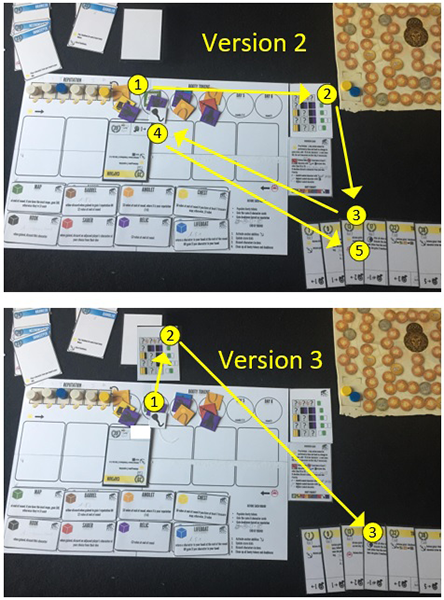
SURPRISES
While Automa now seemed to play fairly smart, based on the loot of the current day, she didn´t hold any surprises for the player and became very predictable. To solve that we marked all cards with abilities, that have the option to mess up your plans with a canon. Occasionally Automa will play one of these instead of going for loot.
THE PILFERER
The original Libertalia was not recommended for 2 players. It didn´t provide enough interaction and excitement. Long before Jamey added the Midshipman 2-player variant, I planned to include a 2nd AI to the solo mode.
It would have been way too much work for the player to handle another full AI, so we only focussed on the loot selection, i. e. having a random third card on the island with its own rank that only takes loot tokens and does nothing else.
Again, we went through a couple iterations. The first one was simply using a regular player deck and playing a random card to the island each turn. It worked but felt very random. Also, having a full card on the ship with lots of text that wasn’t used was distracting. So, I designed cards that show a rank and nothing else. Instead of making a separate deck, I added them upside down to the Automa cards as the Pilferer. Rotate the card to its Pilferer orientation and you only get a rank number.
Image 1 shows the same card used as Automa card (left) and rotated to be used as the Pilferer card (right) (early prototype).
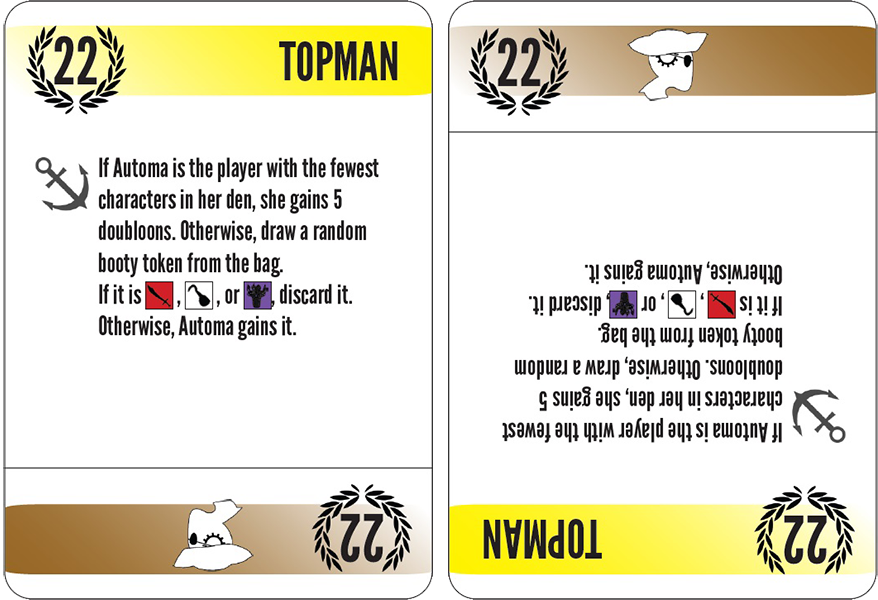
Since you´re drawing the Pilferer card from the remaining cards of the Automa deck you have some knowledge of what ranks are still in the deck and which are already out. The later you are in the game, the smaller this deck gets, meaning that you know even better which rank the Pilferer might play, based on the cards you can see in Automa´s hand and the ones she already played. This kind of predictability fit well with the main concept of the game.
PLAY MODES/LOOT TILES
The different play modes (calm, stormy, and uncharted) provide a lot of replayability and I wanted to make sure to include that in our Automa design.
We sorted the loot tiles by their potential value and created a loot priority list for Automa. Unfortunately, these values changed when playing stormy which led to a different priority list. Having 2 priority lists created some problems. Players needed learn different priority lists dependent on the play mode. Also, which list should we use for uncharted mode, where calm and stormy tiles are mixed up?
Could we keep a single priority list for all playing modes? Yes, but only if the values of the loot tiles didn´t change, regardless of the mode you played. So, we created our own Automa loot tiles that are as close as possible to the original tiles, but their potential values don’t change whichever mode you choose. As a side effect, this also gave us a chance to adjust some text on the tiles to match solo play.
Image 3: The original Saber (left) was conditional, very wordy and complicated. Right: The final Saber tile.
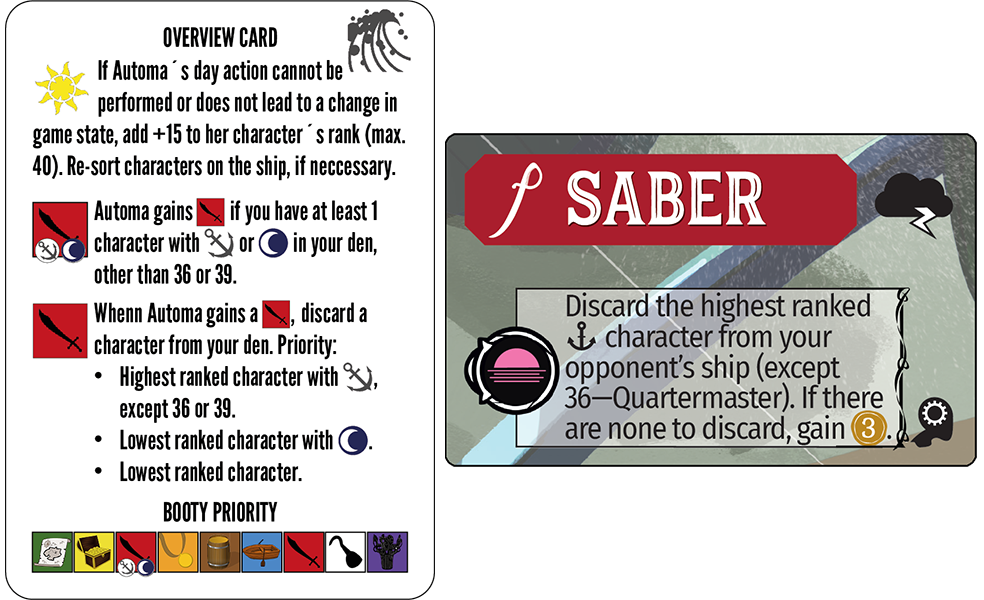
ABILITIES AND FINE TUNING
What followed was a long period of playtesting and fine-tuning. We were aware, that we couldn´t translate each of the 40 abilities to Automa successfully. Some just got too complicated to handle, some needed smart decisions that Automa couldn´t make, and some were overpowered. We also needed to keep the workload for the player as small as possible, so we changed the ones that didn´t lead to meaningful interactions to simply giving Automa doubloons.
Some other abilities were not translatable to Automa and/or caused problems. At one point there were 4 or 5 characters we simply removed from the decks. In the end we found ways to add them back in, except for the Wind Nymph (37).
Throughout the playtests, we made a ton of adjustments to the abilities and the Automa loot tiles to keep her balanced and to reduce swinginess in her scoring.
CONCLUSION
Libertalia depends a lot on getting into your opponent´s head and anticipating their next move. It was hard but fun work to go through all those iterations and come up with a system that hopefully does the game justice. We hope you enjoy playing Libertalia solo.
***
Will you be joining the solo community for Libertalia: Winds of Galecrest?
February 9: Paolo’s Opening & Closing Remarks and Score Dials
As we near the end of these design diary posts, I wanted to bookend Paolo Mori’s Libertalia journey with a few stories.
One you can read here on BoardGameGeek. This is the article that Paolo wrote for BGG back in July 2012 in which he shares the origin story of Libertalia.
Flash forward to the development process for Libertalia: Winds of Galecrest. There’s one component Paolo really wanted in the game that I couldn’t quite get to work (but I also kind of got it to work).
Paolo was hoping that we could include cardboard treasure chests for each player. Thematically, I loved the idea, but I couldn’t find a way to fit them in the box, and they required us to include a lot more coin tokens than were really necessary for the game.
However, I found what I hoped would be an acceptable solution: Instead of including a score track on the game board, we would give each player a score dial…illustrated to look like a treasure chest! While each player’s score is public information, they offer the flexibility of placing them face-down instead if players want to add more secrecy to the game. We calibrated the dials so they only move when you intentionally turn them.
Just to clarify, during each voyage you gain and loose doubloon coin tokens. At the end of the round, you add those doubloons to your score dial (discarding the tokens as you do so), then gain new doubloon coin tokens for the next voyage based on your position on the reputation track ($7-$12).
Here’s Paolo sharing his thoughts on the advance copy of Libertalia: Winds of Galecrest we sent him in December:
“A couple of months ago I received – something more unique than rare in my experience – an advance copy of Libertalia, so I could try it at home in preview (but without being able to boast too publicly, unfortunately!). Opening the box I had the wonderful feeling of a game cared for in every detail, but also with nothing superfluous, added only for an aesthetic function and with no function in the game. Zero air in the box, but also no unnecessary components.
I can’t help but thank Jamey and all the people who worked on this game (I need to mention at least the Automa team for the solo version, and Lamaro Smith for the truly amazing and imaginative artwork!) for the opportunity and for this experience… and hope that players – even those of dear old Libertalia – will love this new edition as much as I loved working on it.”
Thank you, Paolo, for being such a pleasure to collaborate with and for designing such an amazing game…twice! :)
We have just two more days of design diaries: Tomorrow we’ll discuss the robust solo mode, and on Friday I’ll reveal the rulebooks and insert!
February 8: Three Voyages, Graveyard Tile, and Pirate Name Generator
In the original Libertalia, each player starts the first voyage with the same 9 character cards, and you play 6 turns per round. It’s a lot of information to throw at a new player or someone who hasn’t played in a while.
So we made a change for Winds of Galecrest: At the beginning of each voyage, each player gains the same 6 character cards (any player randomly determines these cards)—not 9. As printed on the board, the first voyage is 4 days instead of 6. The second voyage is 5 days, and the third voyage is 6 days. In this way, the game more easily onboards players, then it ramps up as you play. As playtests indicated, this still provided the feel of a full, robust game.
It also retains perhaps my favorite decision space in Libertalia: Which character cards do you choose to NOT play so you can carry them into the next voyage? Typically, you’ll have 2 extra characters at the end of the first voyage, making your starting hand for the second voyage a total of 8 characters. Then you’ll have 3 extra characters to carry over to the final voyage. I love feeling sneaky about the characters I hold onto for the perfect moment.
We also included a new component in the game, something small that’s designed to clear up a mechanical confusion about discarding in the original Libertalia (there were essentially two discard piles per player). In the new edition, each player has a “graveyard” tile, and whenever they discard character cards—whether they’re removed from the island or ship during a voyage or at the end of a voyage—they are placed on that player’s graveyard tile face down.
This means if you use any character ability that refers to your discarded cards, it includes all cards that you’ve discarded so far for the entire game, not just cards discarded during the current voyage (this is distinctly different than the original game). For example, the Surgeon’s Day ability is, “Return a character from your graveyard to your hand (without revealing it).”
Also today I wanted to mention that you can now determine your pirate name on our website thanks to creator Ryan Davis, programmer Vitaliy Fuks, and web developer Dave Hewer. Just click on this link to answer 4 questions—fill in any answer that comes to mind—and then share the resulting pirate and ship name in the comments below. https://stonemaiergames.com/games/libertalia/libertalia-character-discovery/
February 7: Metal Coins and Rolling Realms
So, I want to be very clear up front: There are no metal coins in Libertalia: Winds of Galecrest. That would have knocked the price of the game well above what we wanted it to be. There are cardboard coins in the game, along with a treasure tray/lid.
However, we love custom metal coins here at Stonemaier Games, and we couldn’t resist making some metal coins as an add-on accessory. This pack of 54 metal doubloons created specifically for Libertalia: Winds of Galecrest includes twelve $5 coins, eighteen $3 doubloons, and twenty-four $1 doubloons. They’ll be available at a significant discount during the primary preorder window of March 2-5.
Last, it’s a new tradition at Stonemaier Games to release a Rolling Realms promo pack for all new games we release, and that includes Libertalia! I’ll save the full reveal of this realm for later, but we’ve already made the Libertalia realm pack, and it will be available during the March 2 preorder at a discount.
If you’re new to Rolling Realms, it’s an expandable roll-and-write game where players combine 3 minigames (“realms”) each round in an attempt to earn the most stars. Each minigame is based on either a Stonemaier game or a game we love from another publisher. The Libertalia realm is the third promo so far (after a Terra Mystica realm and a Rolling Realms realm).
What will you add to your Libertalia preorder on March 2?
February 6: Tiebreakers, Reputation, and the Game Board
When Paolo agreed to work with me to create a new, enhanced edition of Libertalia, one of the first things I did—other than play the game—was to consume every review and read every BGG thread about the game. I loved the game, but I wanted to absorb the criticisms to see if we could address them.
Some were easy fixes, like improving the text for a few cards that were frequently debated or removing the Freed Slave character. But for others, we worked from a detailed Google Doc containing the criticisms and possible solutions.
We probably spent the most time on the 40 character cards themselves. It’s difficult to subjectively order them from 1 to 40, but Paolo has a great mind for doing so. We tried to make each ability unique, intuitive, and thematic, keeping in mind that they don’t need to work optimally in all situations, lest we remove the glee of playing the right card at the exact right moment.
One of the biggest criticisms of the original game was the tiebreaker system: When two players simultaneously reveal the same character, in what order are they placed on the island? We discussed various ways to fix it. I proposed a long reputation track to break ties, and Paolo wisely pointed out that such a track could work best if it was exactly 6 spaces, with players jockeying for position on it (and never occupying the same space).
I’m really happy with the final result. Reputation is essentially a new resource that you can gain and lose throughout the game due to loot and character abilities. There are 6 spaces on the reputation track, each of which is always occupied by a reputation token (no matter the player count). The order of the tokens on the track reflects the order in which identical characters are placed on the island (left to right).
While having higher reputation is generally better, you earn more doubloons at the beginning of each round if you’re lower on the reputation track. You just want to be wary about having too little reputation, because if you lose more reputation than the track allows, you immediately lose doubloons.
In playtests we found that the new reputation system offers both clarity and strategy. We learned from 2-player playtests that the reputation tokens at that player count felt the most fair if they started next to each other, so the board indicates that they’re randomized for the center two positions on the track at the beginning of the game.
Also, today’s photos include the game board itself, where you can see that we’ve printed the calm and stormy loot tile abilities directly on the board. So you really only need the loot tiles I described yesterday if you’re playing in uncharted mode (though you can use the tiles to pass around the table if anyone can’t read them upside down).
What type of reputation strategy will you pursue in your first game of Libertalia: Winds of Galecrest?
February 5: Lamaro Smith, Art, and Two-Player Mode
I think the realistic art in the original Libertalia is was well done, and it was perfect for the heyday of Pirates of the Caribbean. But for Libertalia: Winds of Galecrest, we thought it would be best to start fresh, visit a new world, and add quite a bit of brightness and joy to the art.
In my search for various artists who might be a good fit, one stood out: Lamaro Smith. Lamaro is originally from the Bahamas, it’s reflected in the many colorful islands in his art. I was overjoyed when Lamaro accepted the job and began creating the world of Galecrest.
The final result is a vibrant world of vast seas, skies, and islands. The fleets of adventuring pirates take flight for 3 voyages each game, collecting loot each day. Big thanks to Lamaro for bringing the world of Galecrest to life for this new edition of Libertalia!
While I was watching reviews of the original Libertalia, there was a shared sentiment that the game wasn’t ideal for 2-player games. It technically played 2-6 players, but most people wouldn’t pull it off the shelf unless it was for a 3+ player game.
Paolo and I debated a bunch of different ways to improve this aspect of the game. My personal design philosophy and preference is to avoid bots in multiplayer play, so I pushed for something players could set up at the beginning of the game and forget about from then on.
That’s essentially what we ended up with via the Midshipman. When you play Libertalia: Winds of Galecrest as a 2-player pirate duel, you’ll add the Midshipman tile to the board at the beginning of the game. It acts as a third player for the entire game, a player whose only character card is ranked 20.5 (exactly halfway between character 1 and character 40).
Each turn when you reveal cards, you position them next to the Midshipman. If you both play cards higher than 20.5, they go to the right of the Midshipman and nothing special happens.
But if both/either cards are lower than 20.5, one of the cards will end up directly to the left of the Midshipman. The Midshipman has an evening ability (activated during loot selection) that says, “If a character is directly to the left of the Midshipman, that character’s opponent removes a loot token from the current day.”
On the surface, this simply adds a bit more interaction. But it also does something more subtle: In Libertalia, the number of available loot tokens per day is equal to the number of players. The Midshipman acts as a player, so instead of only seeing 2 tokens per day in a 2-player game, there are a total of 3 tokens to choose from. This leads to fewer situations where there isn’t much of a choice between tokens.
I often play games with only 1 other player, so this 2-player mode was really important to me. I’m happy with how it turned out.
What is your most common player count for competitive games?
February 4: Reimagining Libertalia, Paolo’s Perspective, and 40 Characters Cards
Libertalia is one of the first modern tabletop games I fell in love with. It was originally released in 2012, and I remember being enamored by the Dice Tower review of it. I got the game soon afterwards, and I played my copy dozens of times.
During the pandemic, I played Libertalia on Board Game Arena several times. Whenever I posted about it on social media, several people would comment that they wish the game were still in print. A few people even suggested that Stonemaier Games get the rights to the game.
We haven’t ever made a new edition of another publisher’s game, but I started to wonder if that might be a possibility for Libertalia. I contacted the original publisher, only to learn that the rights had reverted to designer Paolo Mori.
Here’s Paulo on what happened next:
“When Jamey contacted me, at the end of 2020, to propose a new edition of Libertalia (not a reprint!) I had no doubts, and I thought it was time to finally get my hands again on a game I’ve always loved.
In previous years I had actually received several requests for the game rights from publishers, but for one reason or another (rights still in the hands of the original publisher, or just unconvincing projects) had never gone through. With Jamey, the decision was really quick: I knew the level of care Stonemaier puts into his games, and I loved the idea of one of my games receiving that kind of care. Moreover, Jamey really seemed to love the game.
Mind you, I love the original edition of Libertalia. I think Studio Marabunta did an outstanding job of development at the time, particularly of the theme and artwork, and contributed a lot to the game’s success. Just so you know: I’ve read so many people calling it the best pirate game around… and to think that in my original prototype the pirates weren’t even there! The reception of the game was however ‘torn’, with a number of players – especially in the United States – who really loved it, and another part – especially in the old world – who almost ignored it. That’s why the game was soon out of print, and in recent years had become a sort of ‘grail’ in the secondary market. And also why my drafts of new characters and loot went back in the drawer.
Luckily, Jamey’s intention was not to reprint the game (did I already say this?), but to make a new edition, extensively revised and updated, in order to solve some small issues of the original game (for example the tie breaking rules, the steep learning curve, or the feeling of three rounds a bit too disconnected from each other… or that bloody uncontrollable monkey! ) and to expand giving it more variability (precisely with new characters and new loot) or playability (with the inevitable Automa version to play solo).”
Back to Jamey: I’ll continue Paolo’s story in a future post. There’s lots to share over the next few days, but today I wanted to share a big change/addition that I hinted at yesterday: The characters cards.
In Libertalia: Winds of Galecrest, each player starts with the same randomly generated group of character cards in hand. You secretly and simultaneously choose a character to play, reveal it at the same time as other players, and place them in a row on the board. Character abilities are activated in ascending order (Day), then they gather a loot token in descending order (Dusk). We’ll talk about the new tiebreaker system soon.
Unless something happens to your character, it’ll end up in your ship for the rest of the current voyage, which is great for characters who have abilities that trigger each Night or at the end of the voyage (Anchor). Any characters you don’t play in the current round carry over to the next round, at which point each player also gains 6 new character cards.
As you can tell, the characters are the heart of the game. We spent a lot of time looking at every single pirate card to refine, enhance, and clarify, and I think that every character card changed mechanically as a result.
During this process, we had way more than 30 ideas for characters, so the final result is that there is a total of 40 character cards in the game, each illustrated by Lamaro Smith and with a card frame designed by Mr Cuddington (all icons aligned on the left for an easy visual while in hand).
Fitting with the world of Galecrest, they’re all anthropomorphic animals (like in Everdell and Root). Unlike the original Libertalia (25 men, 3 women, and 2 animal characters), there’s now an even balance of men and women characters (and a variety of ages among them).
I love the variety of characters in Libertalia: Winds of Galecrest. These photos—taken by the amazing Tim Chuon—feature some of them, and you’ll see others in photos over the next few days. I’ll be back tomorrow with details about the new 2-player mode!
February 3: Island Theme, Loot Tokens, and Loot Tiles
With the original Libertalia already a fully designed, functional, fun game, our goal in reimagining a new edition was to inspect and enhance every aspect of it. Most of this examination was mechanical, but we also looked at it from a thematic standpoint.
For example, in the original Libertalia, why were up to 6 identical crews all on the same ship? We tweaked this a little bit: Each player has their own ship in a pirate fleet, and every day the ships land on an island, with players sending 1 crew member to collect their share of the loot.
Mechanically, to give players ample information to plan ahead, loot tokens are randomly seeded on each day of the voyage players collect loot in descending order: Each day, the highest-ranked character selects the first loot token, and so on down the line.
In the original Libertalia, the loot tokens were singled-sided cardboard tokens—once you gained a loot token, it was hidden information. However, I noticed whenever I played Libertalia that the hidden nature of the loot rarely mattered, especially since the loot tokens were visible when selected. When you pulled them from a bag to seed a new round (1 token per player per day), you’d often have to flip over numerous loot tokens to reveal them—not a bit deal, but slightly cumbersome.
I learned from Azul that pulling chunking, colorful bakelite tokens out of the bag is a delightful experience, so that’s exactly the material and size we used for loot tokens in Libertalia: Winds of Galecrest. The game includes 48 double-sided loot tokens, each with a unique color and icon for colorblind friendliness. You’ll fish them out of a sturdy cloth bag, double-stitched for durability (we learned after Tapestry: Plans & Ploys that single-stitched isn’t enough, nor is a thinner bag).
I think it’s important that loot tokens FEEL like something precious and valuable—that’s what we were aiming for. Also, they’re much easier to pick up from the board than cardboard tokens, so there’s a utility aspect as well.
But what do the tokens do? This is one of the biggest innovations, and it’s inspired both by feedback from the original game and from The Quacks of Quedlinburg.
The original Libertalia has a sharp edge to it—it can be a bit cutthroat. We wanted to give players the opportunity to release the amount of inner pirate that’s best for them and their group.
We accomplished this through a new component called loot tiles. Each tile defines the ability for the corresponding loot tokens for the current game. You can choose to play in “calm” mode for a more peaceful game than the original, “stormy” mode for an even more devious game than the original, or “uncharted” mode for a mix of both calm and stormy abilities.
In addressing player preferences through the loot tiles, this upgrade also adds a huge amount of variability and replayability to the game, particularly in uncharted mode. Or you can just find the best loot tile combination for your group.
One last change worth noting is that we added a little sense of progression to the game, as players don’t carry over much from round to round (characters in your ship are discarded at the end of each voyage). The “calm” hook ability allows you to keep a character in your ship for the next voyage, and the stormy map ability offers the opportunity to keep map tokens into the next voyage.
To clarify: In the original Libertalia, all characters and loot in “dens” were discarded. That’s the same in Libertalia: Winds of Galecrest by default, but tokens like the hook (and even 1 specific character) let you break that rule. Just like in the original Libertalia, in this new edition, any remaining cards in hand transfer over to the next voyage.
Which mode in Libertalia: Winds of Galecrest do you want to try first with your gaming group?
February 2: Facebook Live, the Box, and Launch Signups
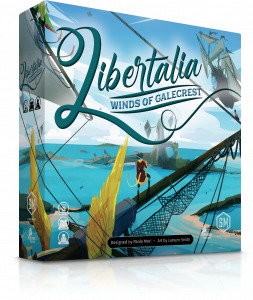
Most design diaries will be written, but for this first day, below is a video of my Facebook livecast in which I answered a number of questions about Libertalia: Winds of Galecrest.
Here’s a quick recap of things I discuss in the video:
- I mentioned that the game plays 1-6 players out of the box, including a robust solo mode and a special 2-player mode.
- I showcased the box, which is our “standard” size of 296x296x70mm.
- I highlighted the art of Lamaro Smith and how receptive designer Paolo Mori was to examining, enhancing, and improving every aspect of the original game. Everything has changed in some way, including every character (and more characters for a total of 40).
- Every first-run copy of the game is individually numbered.
- You can sign up for a preorder launch notification. For each person who does this by February 14, we will donate $1 to Sea Shepherd. The preorder is on March 2, followed immediately after by shipping.
I think those are the major elements I covered in the livestream! I look forward to sharing more tomorrow.
26 Comments on “Design Diary”
Leave a CommentCancel reply
If you ask a question about a specific card or ability, please type the exact text in your comment to help facilitate a speedy and precise answer.
Your comment may take a few minutes to publish. Antagonistic, rude, or degrading comments will be removed. Thank you.
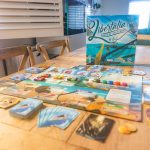
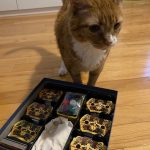
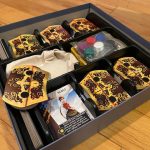
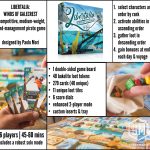
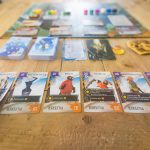
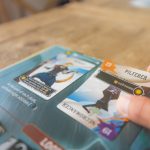

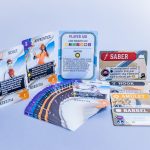
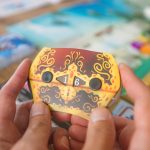
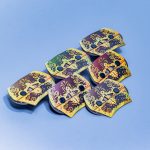
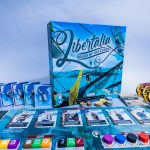
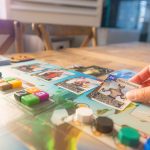


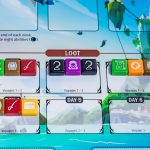
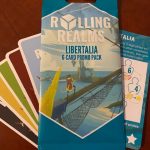
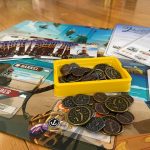
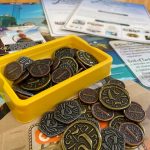
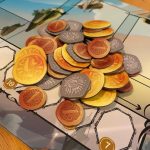
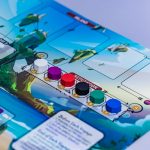
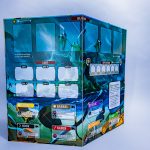
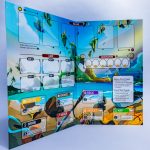

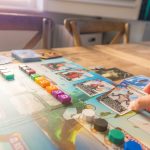
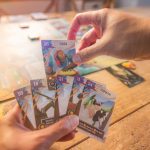
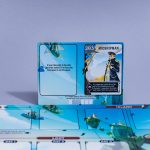
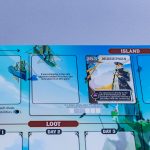
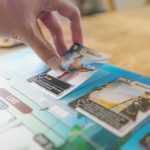
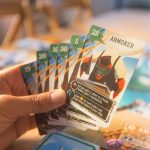
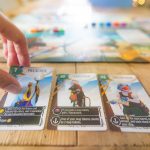
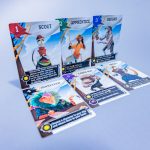
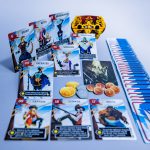
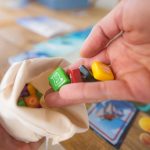



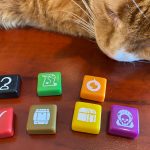
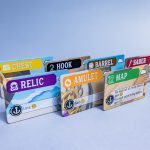
Redarm, Captain of the Broken Shadow :)
Can’t wait until March 2nd!
Some really good insight here on designing the best automa. Thank you!
Aye! I be Greengaze, Captain of the Ominous Monolith!
Fun game! Paleplank, Captain of the Stalwart Madness
Fastdrum, Captain of the Hulking Scythe
Drybird, captain of the Morton typhoon….fun!
Ready for Adventure!
– Youngtooth, Captain of the Hulking Rush
Silverblood, Captain of the Hulking Jungle
Strongbruise—Captain of the Shackled Oath.
This cracks me up. Thanks!
Goldfist, Captain of The Shining Vengeance
Sounds about right haha. Cool extra bit of fun, SM team!
Is there any other “Fastdrum, Captain of the Shining Smoke”?
“I love the idea of the Pirate Name generator!” – Oldface, Captain of the Shining Maelstrom previously known as Carlos Obregon
Hi Jamey,
These design diary posts are a joy to see! I noticed in one of the February 5th post pictures that the coin currency for the game was shone. Just out of curiosity, will Stonemaier be releasing a purchasable metal coin upgrade for this?
Thanks Andrew! Stay tuned for news about this tomorrow. :)
Will do. Thanks, Jamey!
Thanks for todays post!
Our statistics. After 1624 plays for the last few years, 52% are at 2 players (22% 3-player, 16% 4-player). For us the 2-player aspect is important when chosing new games.
So excited this is coming back. Really funny how the original game wasn’t about pirates until the publisher made the choice. Love the artwork on the cards. March 2nd can’t come soon enough.
I think 2022 is the year for pirate games! AHOY from Leder games is also coming out. Both of these look like great additions to my collection.
I wanted to ask reg. the yellow screenprinted loot tiles – will the picture be visible? I always wonder why yellow is chosen for white screenprinting :)
Yes, we used a pretty dark yellow, so the printing is quite visible.
Always love hearing about a new Stonemaier game. How much diversity is there in character design? E.g. gender/ race/ age.
That’s actually the topic of today’s design diary post! I’ll post it in a few minutes. Quick answer: Tons of diversity.
I am looking forward to game play videos. I know nothing of the original Libertalia, so I don’t have a good sense of what it is about. I’ve enjoyed all my Stonemeier games, so will definitely be checking this page every day!
Thanks Karen! They’re coming soon. And I appreciate the reminder that I need to explain how the game works for those who aren’t familiar with the original.
I really like the loot token idea. The ascetics plus the feel for resin/plastic tokens is really cool. I just upgraded my Quacks to the plastic pieces and man does it have a REAL effect on gameplay. Another 10/10 from Stonemaier Games on this one! Am I correct in understanding that if you only pull one map token you get no bonus, you’ll need at least two to get any kind of bonus?
Thanks George! That’s correct–if you only have 1 map token, there’s no end-of-round benefit (but a few characters want maps too).